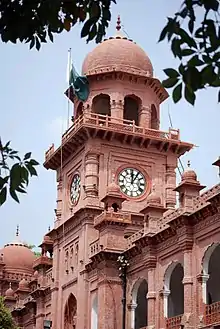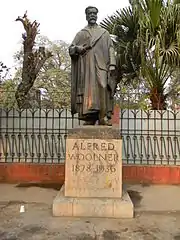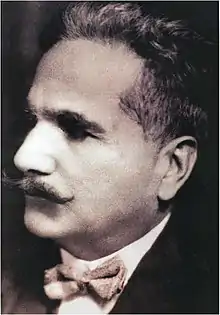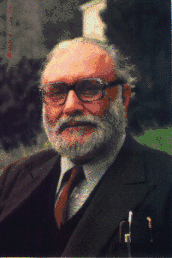University of the Punjab
The University of the Punjab (Urdu: جامعہ پنجاب), also referred to as Punjab University, is a public research university located in Lahore, Punjab, Pakistan. Punjab University is the oldest public university in Pakistan.[1] With multiple campuses in Gujranwala, Jhelum, and Khanspur, the university was formally established by the British Government after convening the first meeting for establishing higher education institutions in October 1882 at Simla.[5] Punjab University was the fourth university to be established by the British colonial authorities in the Indian subcontinent; the first three universities were established in other parts of British India.[6][7]
جامعہ پنجاب | |
 | |
| Motto | ایمان ، اتحاد ، تنظیم (Iman, Ittehad, Tanzeem) |
|---|---|
Motto in English | Faith, Unity, Discipline |
| Type | Public |
| Established | 14 October 1882[1] |
| Chancellor | Chaudhry Mohammad Sarwar |
| Vice-Chancellor | Prof. Dr. Niaz Ahmad Akhtar (SI)[2][3] |
Academic staff | 1006 full time and 300 part time faculty members[1] |
| Students | 45,678 on campus students. (27,907 morning students, 16,552 evening students and 1,219 diploma students), 363,416 (off campus)[4] |
| Location | , , Pakistan |
| Campus | Urban |
| Colours | Blue, bronze, red |
| Affiliations | |
| Website | pu |
There are 45,678 students (27,907 morning students, 16,552 evening students and 1,219 diploma students) who attend the university, and Punjab University has a total of 13 faculties within which there are 83 academic departments, research centers, and institutes.[1] Punjab University has ranked first among large-sized multiple faculty universities by the HEC in 2012.[8] There are also two Nobel Laureates among the university's alumni and former staff.[1] Additionally, the university is also a member of the Association of Commonwealth Universities of the United Kingdom.[9] In the recently issued rankings of Asian universities by QS World Universities Rankings, Punjab University jumped from the 232nd to 193rd position, improving its position by 39 places. Punjab University also ranks 251–300 in the subject of Agriculture and Forestry, 501–550 in the subject of Physics & Astronomy and 501–550 in the subject of Chemistry according to QS World University Rankings by Subject 2019.
History
The University of Punjab[10] was given its initial impetus in 1854 by Wood's despatch. Gottlieb Wilhelm Leitner was the founder of the university. Contrary to the three previously established universities , which were only examining institutions, the University of the Punjab was both a teaching as well as an examining body right from the beginning.
From its formation in 1882 until 1947, the University of the Punjab served the educational needs of the entire region of pre-independence Punjab and northern India. Mohindra College, Patiala was the first college of higher learning to affiliate with University of Punjab in 1882; followed by St. Stephen's College, Delhi. The independence of Pakistan in 1947 reduced the geographical jurisdiction of the university, as it was split into two separate universities in the respective countries. The Indian portion of the university is referred to as Panjab University, Chandigarh, India. The current Institute of Administrative Sciences was created in 1962.
Many major institutions that were previously affiliated to Punjab University have now become independent universities on their own, such as Government College University, Lahore and Medical and Engineering Colleges. [11][12]
Prof. Arthur Compton, who discovered Compton effect used to be an appointed lecturer in University of Punjab and its affiliated campus Government College University, Lahore, he received the Nobel Prize in 1927.[13][14]
Campus

The University of the Punjab is divided into several campuses across Punjab with one summer campus located in Khyber Pakhtunkhwa:[5]
- Allama Iqbal Campus: also known as the old campus, located in the center of Lahore, it is named after the great South Asian thinker and mystic poet Allama Muhammad Iqbal. The campus houses the Senate, the Syndicate, the Selection Board and the Advanced Studies & Research Board are generally held there.[15]

- Quaid-i-Azam Campus: also known as the new campus, it is named after the founder of Pakistan and is located 12 kilometres (7.5 mi) to the south of the Allama Iqbal Campus. Spread over an area of 1,800 acres (7 km2). This campus is the center of academic and administrative activities of the university. A canal divides the academic blocks from the student lodgings.[16]
- Gujranwala Campus: the faculties of Commerce, Economics and Management Sciences, Law and Science all conduct teaching in the campus.[17]
- Khanspur Campus: the summer campus is located at a height of about 7,000 ft (2,100 m) in the Himalayan range near Ayubia. This campus, in addition to providing research facilities, is also used as a recreational center for the faculty and the students.
- Jhelum Campus: having recently opened in 2012,[18] it offers studies relating to the faculties of Commerce, Economics and Management Sciences, Law and Computer Science.[19]
Academics

Faculties
There are 13 faculties in the University with 10 constituent colleges, 73 departments, centres, and institutes. It has 1006 full-time and 300 part-time faculty members involved in teaching/research and over 6,000 non-teaching/supporting staff with 45,678 on campus students (27,907 Morning Students, 16,552 Evening Students and 1,219 Diploma Students) :[20]
- Faculty of Arts and Humanities
- Faculty of Behavioral and Social Sciences
- Faculty of Commerce
- Faculty of Economics and Management Sciences
- Faculty of Education
- Faculty of Engineering & Technology
- Faculty of Health Sciences
- Faculty of Islamic Studies
- Faculty of Law
- Faculty of Life-Sciences
- Faculty of Oriental Learning
- Faculty of Pharmacy
- Faculty of Science

Constituent colleges
- College of Art and Design
- Hailey College of Banking & Finance
- Hailey College of Commerce
- University College of Pharmacy
- Punjab University Law College
- Punjab University College of Information Technology
- College of Statistical and Actuarial Sciences
- College of Engineering & Emerging computing
- College of Earth and Environmental Sciences
- University Oriental College lahore
Punjab University Library
Punjab University Library is one of the largest libraries among the universities of Pakistan. The library has more than 500,000 books, magazines and periodicals in its collection. This collection is in nine different national and international languages and different types as print material, CDs, DVDs, Microfilms, Microfiches, Video and Audio Cassettes and Manuscripts.[21] Punjab University Library has two-storey building and total area of the building is 102,000 sq. feet. There are reading halls in both ground and 1st floor with approximately seating capacity of 2500 readers. The library has internet lab for the students to research according to the new technologies of 21st century. In the library there is computerised "MLIMs" catalogue for searching material.[22]
Notable alumni


- Har Gobind Khorana (Nobel laureate 1968 - Medicine)
- F. C. Kohli Father of Indian IT Industry.
- Abdus Salam (Nobel laureate 1979 - Physics)
- Muhammad Iqbal (Urdu poet, philosopher, and politician)
- Choudhry Rahmat Ali (Founder of the Pakistan Movement, creator of the name Pakistan)
- Chaudry Nazar Muhammad (Sir Ranbir Singh Gold Medalist 1939, Law College) Co-Founder and Chairman Servis Industries Ltd. and Servis Sales Corporation President of the Federation of Pakistan Chambers of Commerce and Industry
- Satish Dhawan (Rocket scientist, Chairman of ISRO, Director of IISc)
- Yash Pal (Educationist and space scientist known for cosmic ray research and popularizing science education in India)
- Ishfaq Ahmad (Theoretical and Nuclear physicist, chairman of PAEC during the first atomic tests in Pakistan in 1998)
- Asma Jahangir (Human rights activist and lawyer, co-founder of Human Rights Commission of Pakistan)
- Muhammad Sharif (Relativistic astrophysicist and cosmologist)
- Syed Ali Shah Geelani ( Leader - Kashmiri Hurriyat, Chairman All Party Hurriyat Conference, Chairman Tehreek-e- Hurriyat, Former member Jamat-ul- islami, Jammu&Kashmir)
- Shoaib Mansoor (Pakistani movie director)
- Bilal U. Haq, marine geoscientist and laureate of France's Prestwich Prize in geology.
- Muhammad Tahir Ul Qadri(Pakistani-Canadian Scholar)
- Yousaf Raza Gillani (Pakistani politician and former Prime Minister during 2008–2012)
- Sartaj Aziz (Pakistani economist, strategist and former NSA)
- Prof. Dr. Niaz Ahmad (SI) (Vice Chancellor, Punjab University Lahore)
- I. K. Gujral (12th Prime Minister of India)
- Wasiullah Khan (Pakistani-American founder of the East–West University in Chicago)
- M. D. Tahir (1942–2008), prominent Pakistani lawyer
- Liaqat Baloch (Pakistani Islamic Activist) 1975–1979 (Jamaat e Islami)
- Manzoor Mirza (1939-2016), economist
- Ather Shah Khan Jaidi, comedian, writer
References
- "Introduction". University of Punjab. Retrieved 26 May 2013.
- "University of the Punjab". pu.edu.pk.
- "In brief". The Nation. 1 June 2018. Retrieved 12 February 2019.
- "Fact Books" (PDF).
- "PU campuses". University of the Punjab. Retrieved 26 May 2013.
- "A History of the University of the Panjab". World Digital Library. Retrieved 26 May 2013.
- "Affiliation". PU. Retrieved 9 September 2013.
- "HEC Pakistan Rankings by research quality". Higher Education Commission of Pakistan. Archived from the original on 13 November 2013. Retrieved 26 May 2013.
- "ACU members". ACU Members. Retrieved 9 September 2013.
- "The University of the Punjab".
- "Educationist; 'Premiere Education Newspaper of Pakistan'".
- "Educational & Career Counseling Portal for Pakistani Students'".
- http://www.thefridaytimes.com/our-lost-heritage-ii/
- http://www.adexen.com/company/202791
- "Allama Iqbal Campus". University of the Punjab. Retrieved 22 November 2012.
- "Quaid-i-Azam Campus". University of the Punjab. Retrieved 22 November 2012.
- "Gujranwala Campus". University of the Punjab. Retrieved 22 November 2012.
- "Punjab University opens Jhelum Campus". pu.edu.pk. Retrieved 3 October 2017.
- "Jhelum Campus". University of the Punjab. Retrieved 22 November 2012.
- "University of the Punjab official website". Pu.edu.pk. Retrieved 1 November 2012.
- "Punjab University Library Introduction". pu.edu.pk. Retrieved 3 October 2017.
- "Punjab University Library – History and Introduction". Pulibrary.edu.pk. Retrieved 23 October 2011.